Airfix 1/72 DH.89A Dragon Rapide
|
KIT #: |
4047 |
|
PRICE: |
$ 18.00 or so
|
|
DECALS: |
Three options |
|
REVIEWER: |
Peter Burstow |
|
NOTES: |
Heller molding.
Heller –
80345, Tasman - UG2001 |
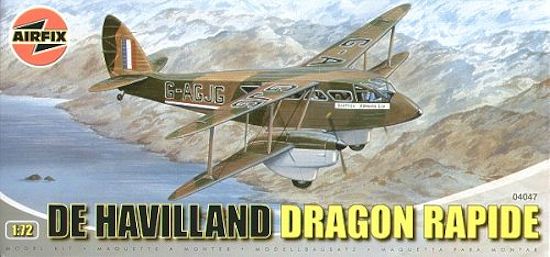
First
flown in 1934, the DH 89 Dragon Rapide was a faster version of the DH 84 Dragon.
It shared features of the larger four engined DH 86 Express. A small eight
passenger biplane, it was one of the most successful of the pre WW2 airliners,
being able to operate profitably without subsidies. In 1936 small upgrades were
made, including the addition of flaps, producing the DH 89A
Around 500 of the military version,
the DH 89B Dominie, were built for the RAF, used as a ambulance, trainer and
communications aircraft. Total production was 731, the last few being assembled
from spares. Post war many were returned to civil use and there were a number of
conversions with newer model Gypsy engines. Many examples are preserved and some
are still flying.
Six were license produced in
Italy, in modified form, as the Breda Ba 44.
There is a huge
list of both commercial and military operators, before, during and after World
War Two. It being one of the few aircraft operated by both sides during WW2. It
was also used by many private and company owners.
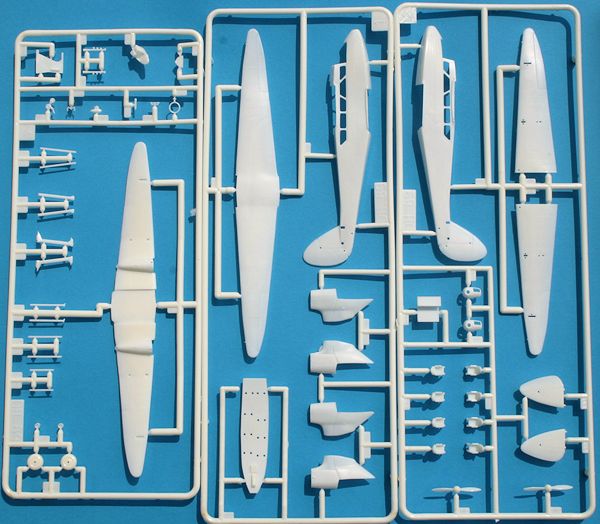 I have two
different boxings of this kit. Originally produced by Heller in the late 1970's,
it was reboxed both by Airfix and by Tasman from New Zealand. I'll describe the
kit in detail and outline the differences. The Heller boxing is in current
catalogues, and the Airfix boxing is still around. There are about 60 parts in
total. I downloaded a copy of the Heller instructions from the Heller site, for
comparison purposes.
I have two
different boxings of this kit. Originally produced by Heller in the late 1970's,
it was reboxed both by Airfix and by Tasman from New Zealand. I'll describe the
kit in detail and outline the differences. The Heller boxing is in current
catalogues, and the Airfix boxing is still around. There are about 60 parts in
total. I downloaded a copy of the Heller instructions from the Heller site, for
comparison purposes.
Airfix:
Large top opening box. Three sprues of hard silver-grey plastic, cleanly moulded
with very slight flash and mould joint lines. Very fine raised line detail, with
no fabric effect, which this kit needs. There is a prominent Heller badge on the
inside of the port fuselage half. The sprues were loose in the sealed box, and a
lot of the parts had broken loose, it remains to be seen if there is any damage.
The clear parts were also loose in the box.
Tasman:
Slightly smaller top opening box. The same parts, in soft white plastic, bagged
inside the box. Again very slight flash and mould joint lines. Clear parts in
the same bag, with the cockpit canopy part broken off. The Heller badge is on
the inside of the top wing top half, so a different mould. There are
additionally a vac-formed cockpit canopy, a piece of tinted clear card, a white
metal instrument panel and some stranded copper wire for rigging.
Common to both
boxings:
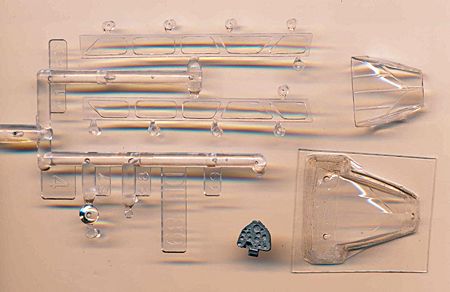 The
cockpit has minor detailing of a seat, control column with separate yoke, and
rudder bar, all to be attached to the floor. An instrument panel attaches to the
fuselage half. A bulkhead divides the cabin space which has eight seats to be
installed. The engine nacelle assembly is made up of seven parts and includes
the wheel fairings and an exhaust pipe.
The
cockpit has minor detailing of a seat, control column with separate yoke, and
rudder bar, all to be attached to the floor. An instrument panel attaches to the
fuselage half. A bulkhead divides the cabin space which has eight seats to be
installed. The engine nacelle assembly is made up of seven parts and includes
the wheel fairings and an exhaust pipe.
The clear parts
comprise a cockpit canopy, two strips of cabin windows, and landing lights. The
moulding is clear and thin, with well defined framing lines. Both canopies were
slightly scratched, and the cabin windows had distortions and sink marks. The
Tasman vac-formed canopy is very thin and clear, but the framing lines are not
as sharp as on the the injection moulded canopies.
The
remaining parts are the three part top wing, and the single piece lower wing,
the tail plane halves and a few stray aerials, tailwheel, lading lights etc.
Rigging is rather complex as it is a two bay biplane, but should be attempted to
enhance and strengthen the kit. Detail could be added to the cockpit and
engines.
The main
difference between the boxings is in the schemes and decals provided.
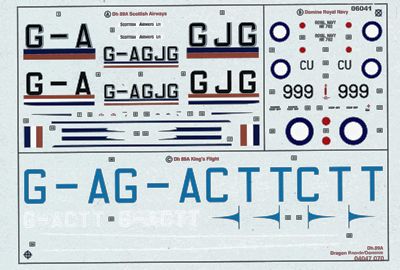 Airfix:
Three versions, a camouflaged Scottish Airways plane, a silver FAA example from
1960, and a Red and Blue civil registered plane from the King's Flight. The
large decal sheet has lots of stencilling and other small markings.
Airfix:
Three versions, a camouflaged Scottish Airways plane, a silver FAA example from
1960, and a Red and Blue civil registered plane from the King's Flight. The
large decal sheet has lots of stencilling and other small markings.
Tasman: Five
versions, two camouflaged USAAF planes, a camouflaged RAF ambulance aircraft,
and silver RAAF and RNZAF examples. The Scalemaster sheet has insignia and
serials, with one of the USAAF aircraft being named 'Wee Willie' and the RAF
ambulance 'Women of the Empire'. I photoshopped the decal scan to enhance the
white printing.
Heller:
Current catalogue kit has two schemes, camouflaged RAF and British civil. Older
boxings may differ.
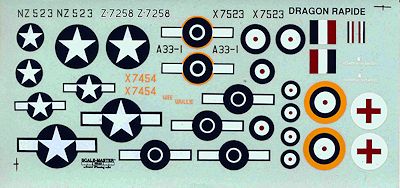 Airfix
& Heller instructions:
An eight page A4 booklet with a short history, a page of warnings in about 12
languages, a 12 step assembly guide including detailed rigging information, and
detailed 4 view profiles for the supplied options. Only Humbrol paint numbers
are referenced, including several that need mixing. There is no reference to
what the colours really are.
Airfix
& Heller instructions:
An eight page A4 booklet with a short history, a page of warnings in about 12
languages, a 12 step assembly guide including detailed rigging information, and
detailed 4 view profiles for the supplied options. Only Humbrol paint numbers
are referenced, including several that need mixing. There is no reference to
what the colours really are.
Tasman
instructions: Eight
pages of A4, with a lengthy history, a long list of things to fix and detail on
the kit, rigging information, comprehensive reference list, and small exploded
diagram assembly instructions. It includes diagrams for detailing the cabin of
an ambulance version. There are two pages of profiles, with notes and named
colours. The main feature is four pages of pictures of a preserved aircraft with
42 internal and external detail photographs.
An
attractive kit of a very handsome biplane airliner, the kit is the same in all
boxings, with different decals and some extra parts in the Tasman kit. Choice
will probably depend on availability. The Airfix and Heller boxings are still
around. The Tasman boxing, only produced in small numbers, is probably long
gone. The detailed photographs on the Tasman instruction sheet are a real bonus,
and it is probably worth seeking it out just for them.
There
were around 90 military and civil operators of the aircraft so there is plenty
of scope for other schemes. There have been a number of aftermarket decal sheets
produced for this kit, I'm not sure which are still available. Kuivalainen
produce a pre-printed photo-etched detail set for the kit (KPE72032). I'm
going to build the Airfix boxing first, for the not very good reason that the
box is a little bigger so I'll reclaim a bit more space in the stash. Haven't
decided which scheme to use.
Recommended.
http://en.wikipedia.org/wiki/De_Havilland_DH.89_Dragon_Rapide
http://www.heller.fr/en/maquettes/military-air-force/100-dh-dragon-rapide.html
A.J.
Jackson, British Civil Aircraft 1919-1972: Volume II. Putnam, London, 1973.
Peter
Burstow
If you would like your product reviewed fairly and fairly quickly, please
contact the editor or see other details in the
Note to
Contributors.
Back to the Main Page
Back to the Previews Index Page


 I have two
different boxings of this kit. Originally produced by Heller in the late 1970's,
it was reboxed both by Airfix and by Tasman from New Zealand. I'll describe the
kit in detail and outline the differences. The Heller boxing is in current
catalogues, and the Airfix boxing is still around. There are about 60 parts in
total. I downloaded a copy of the Heller instructions from the Heller site, for
comparison purposes.
I have two
different boxings of this kit. Originally produced by Heller in the late 1970's,
it was reboxed both by Airfix and by Tasman from New Zealand. I'll describe the
kit in detail and outline the differences. The Heller boxing is in current
catalogues, and the Airfix boxing is still around. There are about 60 parts in
total. I downloaded a copy of the Heller instructions from the Heller site, for
comparison purposes.

